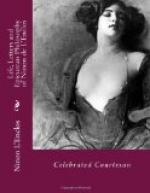But Madame de Sevigne, to whom her son had confessed his folly in giving up the letters, perhaps fearing to be embroiled in a disgraceful duel over an actress, made him blush at his cruel sacrifice of a woman who loved him, and made him understand that even in dishonesty there were certain rules of honesty to be observed. She worked upon his mind until he felt that he had committed a dishonorable act, and when he had reached that point, it was easy to get the letters away from Ninon partly by artifice, partly by force. Madame de Sevigne tells the story in a letter to her daughter, Madame de Grignan:
“Elle (Ninon) voulut l’autre jour lui faire donner des lettres de la comedienne (Champmele); il les lui donna; elle en etait jalouse; elle voulait les donner a un amant de la princesse, afin de lui faire donner quelque coups de baudrier. Il me le vint dire: je lui fis voir que c’etait une infamie de couper ainsi la gorge a une petite creature pour l’avoir aimer; je representai qu’elle n’avait point sacrifie ses lettres, comme on voulait lui faire croire pour l’animer. Il entra dans mes raisons; il courut chez Ninon, et moitie par adresse, et moitie par force, il retira les lettres de cette pauvre diablesse.”
It was easy for a doting mother like Madame de Sevigne to credit everything her son manufactured for her delectation. The dramatic incident of de Sevigne taking letters from Ninon de l’Enclos partly by ingenuity and partly by force, resembled his tale that he had left Ninon and that he did not care for her while all the time they were inseparable. He was truly a lover of Penelope, the bow of Ulysses having betrayed his weakness.
“The malady of his soul,” says his mother, “afflicted his body. He thought himself like the good Esos; he would have himself boiled in a caldron with aromatic herbs to restore his vigor.”
But Ninon’s opinion of him was somewhat different. She lamented his untimely end, but did not hesitate to express her views.
“He was a man beyond definition,” was her panegyric. “He possessed a soul of pulp, a body of wet paper, and a heart of pumpkin fricasseed in snow.”
She finally became ashamed of ever having loved him, and insisted that they were never more than brother and sister. She tried to make something out of him by exposing all the secrets of the female heart, and initiating him in the mysteries of human love, but as she said: “His heart was a pumpkin fricasseed in snow.”




